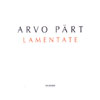Pärt Da pacem Domine; Lamentate
Pärt’s moving lament for the living brings from him rarely heard power
View record and artist detailsRecord and Artist Details
Composer or Director: Arvo Pärt
Genre:
Orchestral
Label: ECM New Series
Magazine Review Date: 11/2005
Media Format: CD or Download
Media Runtime: 43
Mastering:
Stereo
DDD
Catalogue Number: 476 3048

Tracks:
| Composition | Artist Credit |
|---|---|
| Da pacem Domine |
Arvo Pärt, Composer
Arvo Pärt, Composer Hilliard Ensemble |
| Lamentate |
Arvo Pärt, Composer
Alexei Lubimov, Piano Andrey Boreyko, Conductor Arvo Pärt, Composer Stuttgart Radio Symphony Orchestra |
Author: bwitherden
ECM founder Manfred Eicher has more justification than most to revel in the celebrations of Arvo Pärt’s 70th birthday. Tabula rasa (1984) launched ECM’s New Series and introduced Pärt to a wider audience. Eight further beautifully produced, highly acclaimed albums revealed the developing glories of Pärt’s music.
The main piece on this latest release has passages of visceral power unheard in Pärt’s work for almost three decades. Lamentate was inspired by Anish Kapoor’s gigantic sculpture Marsyas, which filled the Turbine Hall at Tate Modern in London. Confronted with this monumental work, Pärt felt he was standing before his own body after death. ‘I had a strong sense of not being ready to die,’ he says, ‘and was moved to ask myself what I could still accomplish in the time left to me.'
Lamentate is intended as a lament for the living, ‘struggling with the pain and hopelessness of this world’. The solo piano part can be seen as the first person narrative of an individual, beset by challenges represented by the orchestra, which uses sharper textures, more dramatic gestures and a broader range of colours than we usually expect from this most controlled and ascetic of composers. It makes one eager to know what his next step will be.
In Da pacem Domine (2004), for which Sarah Leonard extends the Hilliard’s range, Pärt takes a ninth-century antiphon as his starting-point, floating the serene, radiant lines of this prayer for peace with characteristic airy grace, slowly opening up the textures and exploring some tart harmonies before returning to a final consoling chord.
The main piece on this latest release has passages of visceral power unheard in Pärt’s work for almost three decades. Lamentate was inspired by Anish Kapoor’s gigantic sculpture Marsyas, which filled the Turbine Hall at Tate Modern in London. Confronted with this monumental work, Pärt felt he was standing before his own body after death. ‘I had a strong sense of not being ready to die,’ he says, ‘and was moved to ask myself what I could still accomplish in the time left to me.'
Lamentate is intended as a lament for the living, ‘struggling with the pain and hopelessness of this world’. The solo piano part can be seen as the first person narrative of an individual, beset by challenges represented by the orchestra, which uses sharper textures, more dramatic gestures and a broader range of colours than we usually expect from this most controlled and ascetic of composers. It makes one eager to know what his next step will be.
In Da pacem Domine (2004), for which Sarah Leonard extends the Hilliard’s range, Pärt takes a ninth-century antiphon as his starting-point, floating the serene, radiant lines of this prayer for peace with characteristic airy grace, slowly opening up the textures and exploring some tart harmonies before returning to a final consoling chord.
Discover the world's largest classical music catalogue with Presto Music.

Gramophone Digital Club
- Digital Edition
- Digital Archive
- Reviews Database
- Full website access
From £8.75 / month
Subscribe
Gramophone Full Club
- Print Edition
- Digital Edition
- Digital Archive
- Reviews Database
- Full website access
From £11.00 / month
Subscribe
If you are a library, university or other organisation that would be interested in an institutional subscription to Gramophone please click here for further information.




